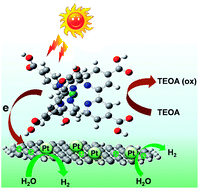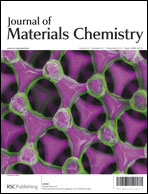Herein, we report an efficient photocatalytic hydrogen evolution system based on Ru-tris(dicarboxybipyridine)–reduced graphene oxide (Ru(dcbpy)3–RGO) hybrid. AFM images and UV-vis spectra validate Ru(dcbpy)3 functionalized RGO via noncovalent interactions. Fluorescence and Raman spectra suggest that Ru(dcbpy)3 acts as an electron donor and RGO serves as an electron acceptor in the hybridized species. Moreover, the photocurrent experiment further confirms that the photoelectrons transfer from Ru(dcbpy)3 to RGO nanosheets and then flow to deposited Pt nanoparticles effectively. Compared with the corresponding single-component Ru(dcbpy)3 and RGO nanosheets, the Ru(dcbpy)3–RGO hybrid displays distinctly enhanced photocatalytic activities under UV-vis or visible light irradiation. Therein, RGO acts as a solid-state electron mediator, which facilitates charge separation and suppresses recombination of photoexcited electron–hole pairs in RGO–Ru(dcbpy)3. Furthermore, the effect of reaction parameters such as pH, the composition of the hybrid and the stability of catalytic performance are also investigated. This study might initiate new possibilities for the development of novel graphene-based photocatalysts with enhanced activity via facile noncovalent modification of graphene with organic photosensitizers.

You have access to this article
 Please wait while we load your content...
Something went wrong. Try again?
Please wait while we load your content...
Something went wrong. Try again?


 Please wait while we load your content...
Please wait while we load your content...